Breakfast was made by our host and served in the tiny kitchen with tiny silverware (I loved the tiny breakfast silverware most places had). It was a boiled egg, bread with fig jam and marmalade, grapes, and a homemade donut fried up on the spot. The orange "juice" we'd been having everywhere was Fanta, I discovered, when he poured it from the bottle. Because of the situation, I had to drink it. Yum, koolaid for breakfast. The breakfast wasn't as much as we'd been having, and it showed by the afternoon!
During our breakfast, our host and his sister got in a huge fight. What is with the squabbling elderly in this town? At least this time it did not appear to be over tourists. The upshot of it was that he said he had to do grocery shopping but had missed to bus. Could we give him a ride to Itea on our way to Delphi? Sure, why not. He got ready quickly so we hustled to get our stuff and head out. We dropped him outside Itea (at his direction) and headed on to Delphi. The drive is about half an hour, half of it on beautiful coast (interrupted by mines that leave a fine red dust everywhere) and half in mountains.
There is no parking lot at Delphi, just shoulder parking. Greece is funny--it has really exquisite museums (every one we visited was a gem) and tons of great, cheap restaurants, but it is missing a lot of profitable tourist infrastructure. There should be parking lots where you pay a couple Euro, and then buses to the sites. The admission prices are ridiculously low. Most places don't sell any tourist crap; we didn't find any real tourist crap type stores until we got to Athens. The museum shops are tiny and usually have postcards and mini statues, with a few very nice and very expensive jewelry repro pieces. There should be more to buy!
All I'm saying is, people will fork over for ridiculous things on holiday, and the Greeks--whose main industry is tourism--should be cashing in. Whither the plastic backscratcher ending in a Corinthian column? There is a market for that sort of thing, people! I am more American than I think in this way, I found. I would never buy a plastic backscratcher ending in a Corinthian column, and I am grateful that we ran across no such thing. But instead of admiring the integrity and purity of the culture, I want to tell them to get with the program and give the people the trash they want while laughing all the way to the bank.
I do wish there had been more affordable, and more of, reproduction jewelry. The gold in the museum collections is just jaw dropping. I wouldn't turn my nose up at gold plating on a 30E reproduction item. But mostly all that was available was 300E solid gold items. Way out of my league. K had gotten her lovely affordable earrings from the tourist stand in Vergina, but that was really all we saw.
Combined admission to the museum and the site at Delphi is 9E (nobody checked our ticket at the Gymnasium and Athena Pronaia site; I'm not sure if it's included in the ticket or is just free). It was another great museum. The site is reasonably well-signed for Greece, which means there was an occasional marble block with the name of the location carved in. This is a well-visited site, and has been for over 2500 years so the path and rocks are worn smooth and slippery, If it's raining the day you plan to visit and you have a choice of what day to go, I recommend you wait for a dry day if you can.
 The site is big, and goes straight up a mountainside. Around the beginning is the rock of the sybil, where the first seeress made her prophecies, which started the tradition of Delphi as a place to go to be in the know. Well, I don't know exactly where the chicken-and-egg started.
The site is big, and goes straight up a mountainside. Around the beginning is the rock of the sybil, where the first seeress made her prophecies, which started the tradition of Delphi as a place to go to be in the know. Well, I don't know exactly where the chicken-and-egg started. The legend of Delphi is that Zeus wanted to locate the center of the world so he released two doves, and their paths crossed at Delphi, which made it the center of the world. They way it worked later was that a priestess, over 50, would sit on a tripod over a crack in the earth from which some sort of vapor wafted, and would go into a trance. According to accounts, she would speak gibberish in the trance, which the priests would "translate" into enigmatical verse for the asker of the question. This, predictably, totally downplays the role of the woman in all this, implying that she is merely hysterical and a cover for the priests to manipulate history. I hope that she had a little more to do with it.
A tripod, we discovered, basically looks like a cauldron set on a three sticks, and does not look comfortable for sitting. While all the accounts we read mentioned the crack in the earth and its vaporous gases, nowhere does anybody talk about where the crack might be and what the gases were. This website has an interesting discussion about it, with some theories as to what the gas was.

At the top of the site is the stadium, which is in really remarkable condition and worth the hike. The marble starting blocks for the foot-racers are still in place!
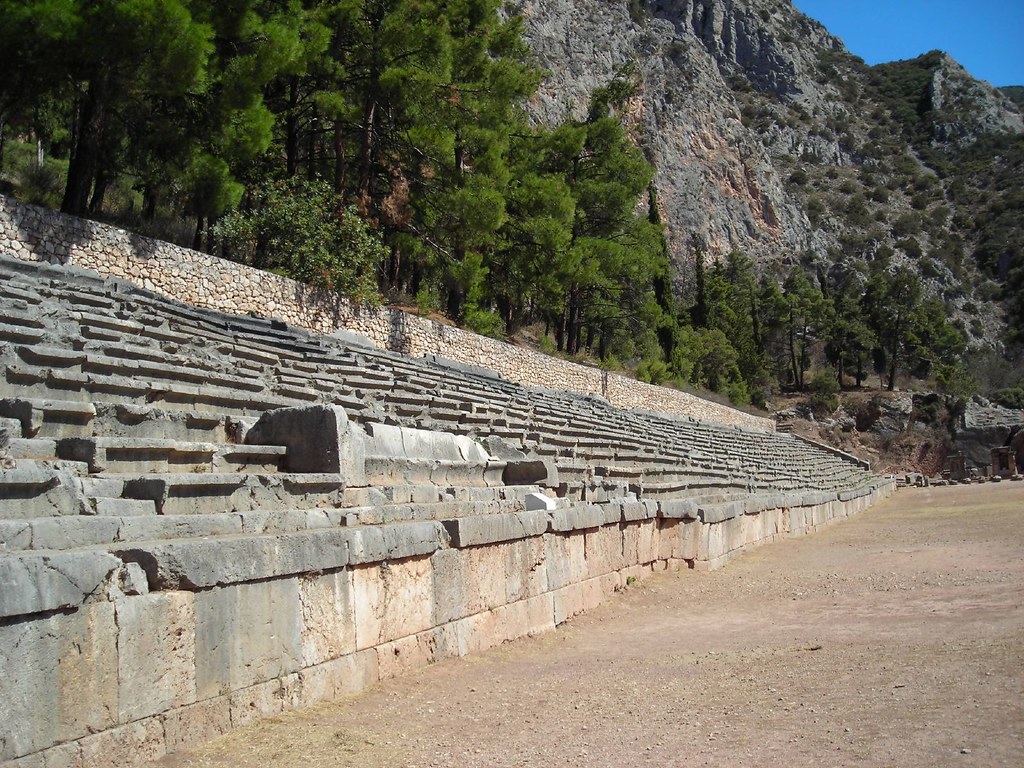 The stadium is one stade long; I'm not quite sure how long a stade is but it was quite lengthy for a sprint. I was surprised how long it was. As we left the stadium we could hear people cheering, so it seemed that somebody had started a race. It was really fun to hear the cheering.
The stadium is one stade long; I'm not quite sure how long a stade is but it was quite lengthy for a sprint. I was surprised how long it was. As we left the stadium we could hear people cheering, so it seemed that somebody had started a race. It was really fun to hear the cheering.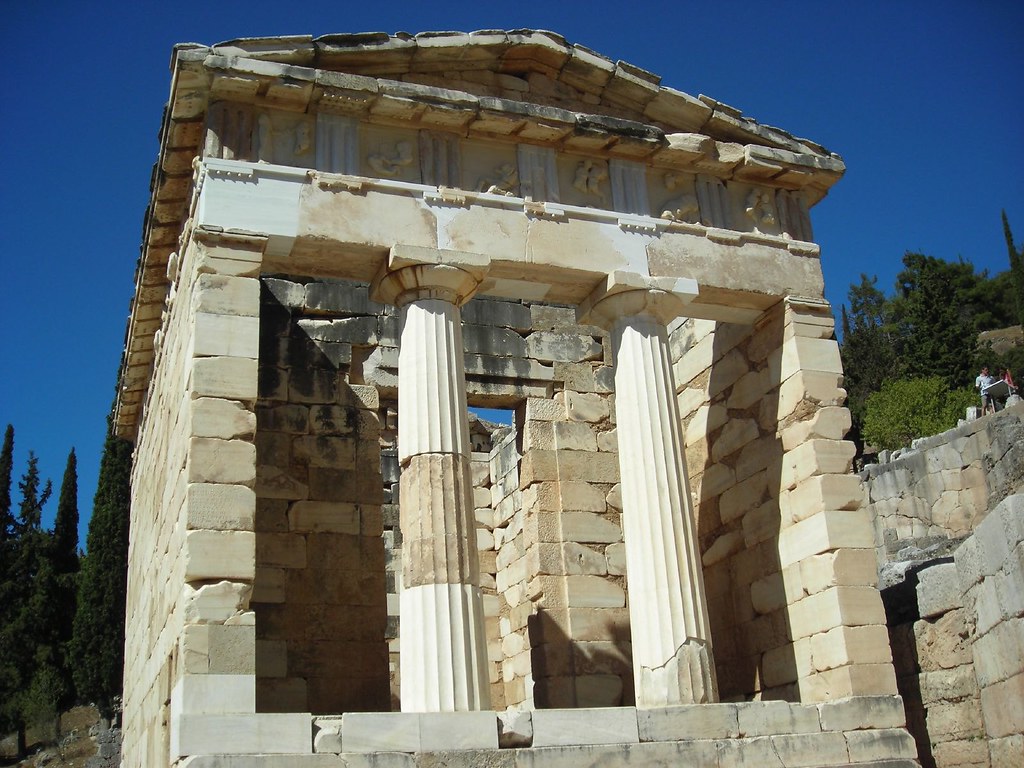 The Athenian Treasury has been reconstructed to give an idea what the whole place might have looked like crammed with all these treasuries. I don't quite understand how it all worked. A city would bring offerings to Delphi and keep them in the treasury--statues, pottery, gold. What happened to it after that, I don't know. It sounded like it just piled up in there, but priests through the ages, of whatever religion, have generally managed to avail themselves of the offerings made to gods. Maybe they got to take a percentage or something.
The Athenian Treasury has been reconstructed to give an idea what the whole place might have looked like crammed with all these treasuries. I don't quite understand how it all worked. A city would bring offerings to Delphi and keep them in the treasury--statues, pottery, gold. What happened to it after that, I don't know. It sounded like it just piled up in there, but priests through the ages, of whatever religion, have generally managed to avail themselves of the offerings made to gods. Maybe they got to take a percentage or something. Back in the day, the Sacred Way was just stuffed with statues, hundreds lined it all jammed up together. Winning an event at the stadium gained you a laurel leaf crown and the right to have your statue erected in the city. No explanation of who paid for the statue, so I don't know if you automatically got a statue, or you got a statue if you could find a wealthy patron to put it up for you. Because of the whole mapping issue we were never quite sure when or if we were on the Sacred Way, but with all the pedestals lining this road I'm calling it.
Back in the day, the Sacred Way was just stuffed with statues, hundreds lined it all jammed up together. Winning an event at the stadium gained you a laurel leaf crown and the right to have your statue erected in the city. No explanation of who paid for the statue, so I don't know if you automatically got a statue, or you got a statue if you could find a wealthy patron to put it up for you. Because of the whole mapping issue we were never quite sure when or if we were on the Sacred Way, but with all the pedestals lining this road I'm calling it.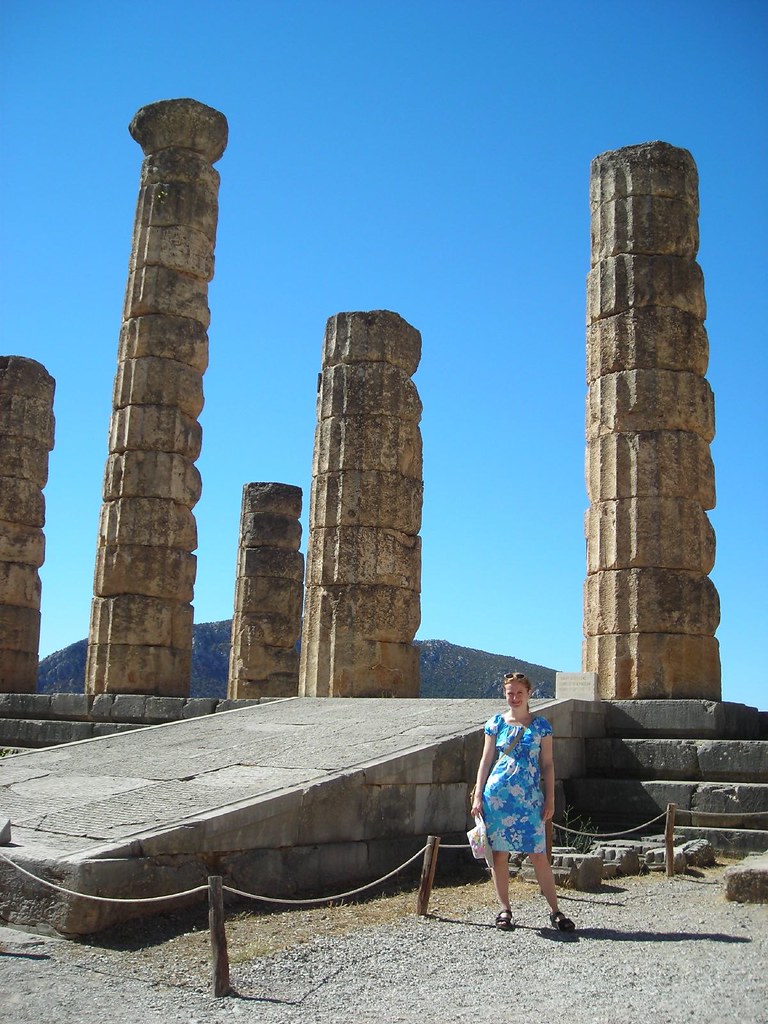
In addition to reconstructing the Athenian Treasury, the archaeologists have put up several pillars at the Temple of Apollo, which makes for some dramatic shots and a good photo op.
Below the site and a very easy walk down the road (there's really no need to drive, I promise) is the Gymnasium and the temple of Athena Pronaia. Again you see the similarity between the ancient religion and Christianity. Mary appears in many guises (in Catholicism and other orthodox religions, at least)--Our Lady of Perpetual Succour, Our Lady of Sorrows, The Virgin of the Rock, etc. The Greek goddesses are the same; Athena Pronaia meant "Athena before the Temple," and was also a pun meaning "Athena of Forethought." We also saw temples to Artemis as protector of women in childbirth, and other roles of other goddesses.
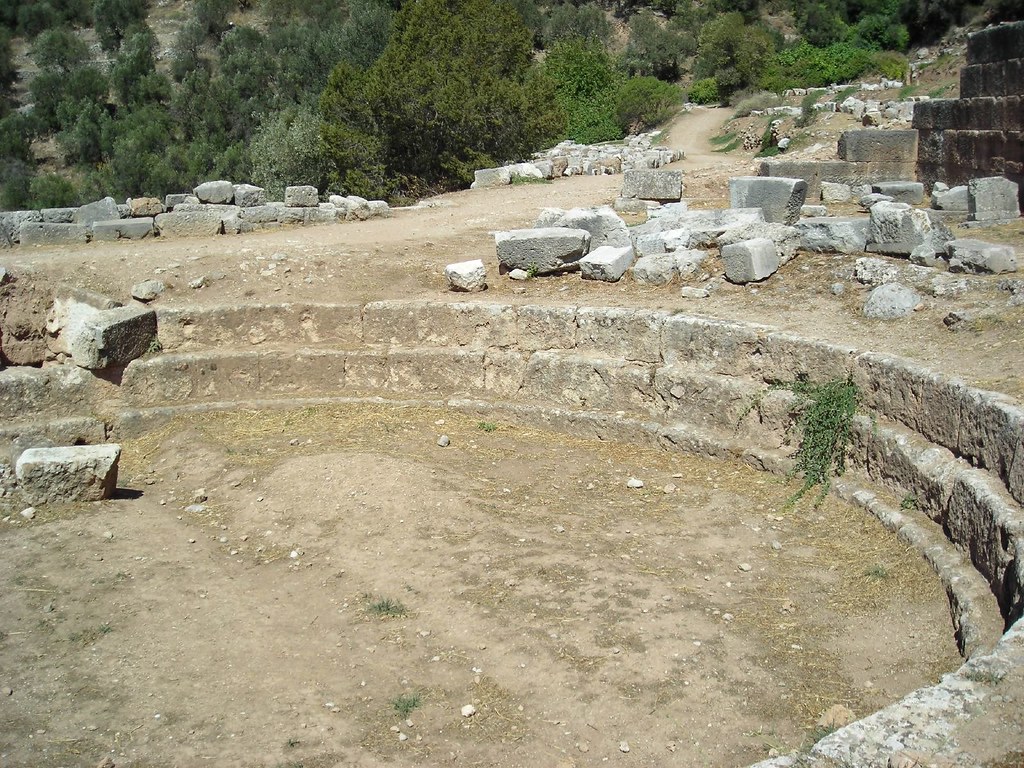 The Gymnasium was where the athletes trained to compete in the stadium. In addition to running, boxing was practiced there. Unlike the luxurious Roman baths we saw everywhere else, with their cold, tepid, and finally hot rooms, this had only a cold bath straight from the spring. The spring in the area was sacred (fresh water from the earth definitely seems sacred), and before the priestess could sit as the Oracle she had to wash her hair in it. I think I'd decline. I cannot handle a cold shower.
The Gymnasium was where the athletes trained to compete in the stadium. In addition to running, boxing was practiced there. Unlike the luxurious Roman baths we saw everywhere else, with their cold, tepid, and finally hot rooms, this had only a cold bath straight from the spring. The spring in the area was sacred (fresh water from the earth definitely seems sacred), and before the priestess could sit as the Oracle she had to wash her hair in it. I think I'd decline. I cannot handle a cold shower.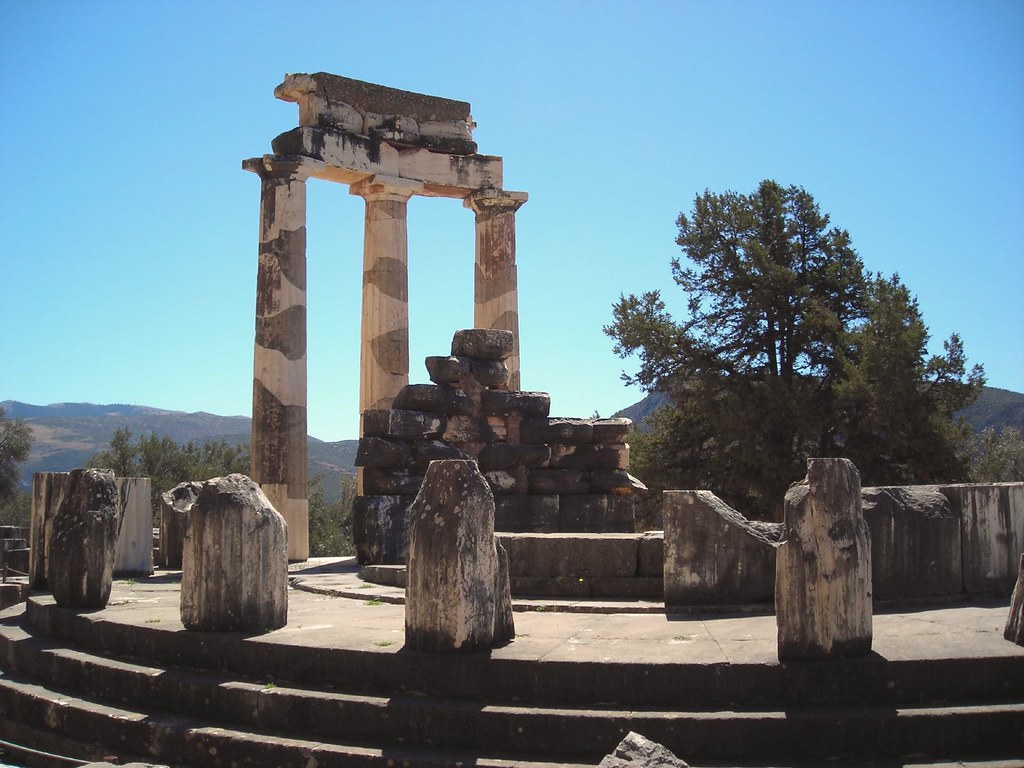 Down from the Gymnasium is the temple of Athena Pronaia, where one of the structures was round with twenty columns; it has been called the Tholos and nobody knows its exact function. In Athens we learned at the Ancient Agora that the original parliament-type building was also round, also called the Tholos, and that the word means "beehive." All I know is they have re-erected three columns and a bit of the frieze and it is awesome.
Down from the Gymnasium is the temple of Athena Pronaia, where one of the structures was round with twenty columns; it has been called the Tholos and nobody knows its exact function. In Athens we learned at the Ancient Agora that the original parliament-type building was also round, also called the Tholos, and that the word means "beehive." All I know is they have re-erected three columns and a bit of the frieze and it is awesome. 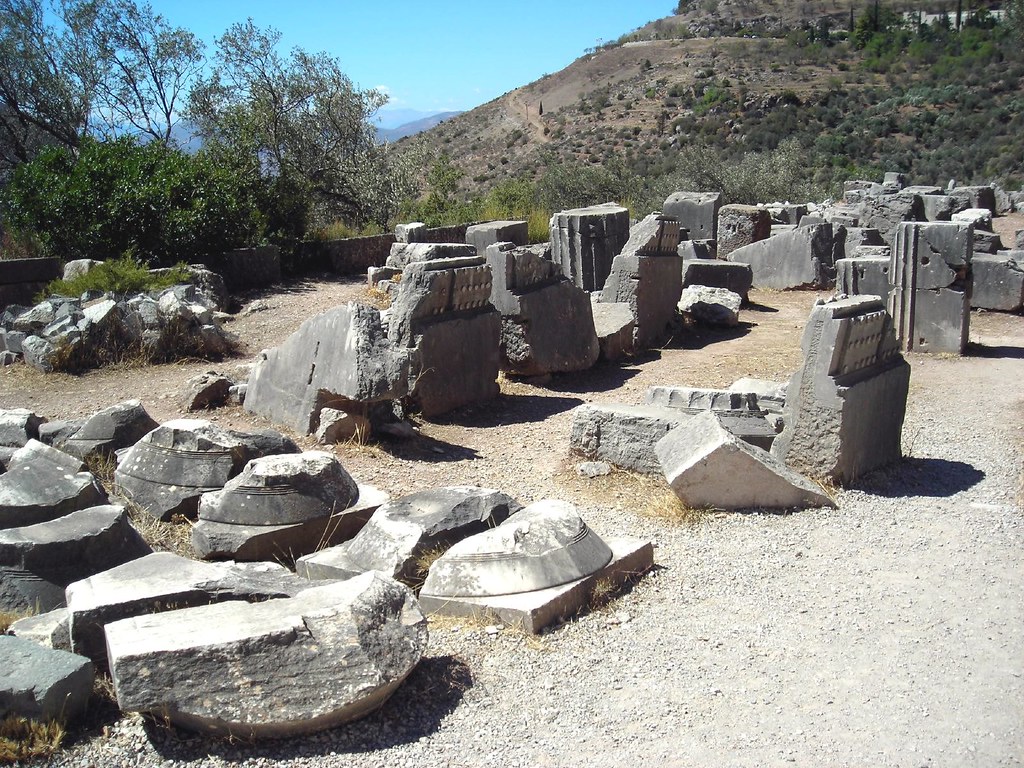
There are a lot of bits and pieces lying round with some interesting decorative work and textures.
Back at the museum we stopped for refreshment. We had noticed a juice bar at the museum and went back. What we thought was juice or smoothies turned out to be slushies. More koolaid. They appear to have a thing for artificially colored sugar water in Greece. The were a not-worth-it 3.50E, but the cold felt good on my sore throat. While I had been feeling peppy while we were walking around, the minute I sat down I remembered again how sick I was.
I got some arty postcards at the museum store, and there is a tiny post office there with an English speaking clerk where I got 8 postcard stamps for 5.10E. Then we went back to the Gymnasium and Athena Pronaia to get cheesy postcards from the tourist shop, including an awesome 3D/picture changing one for my nephew whose birthday I missed while I was gone.
You can see all my photos from Delphi and all the photos from this trip to Greece if you'd like.
No comments:
Post a Comment